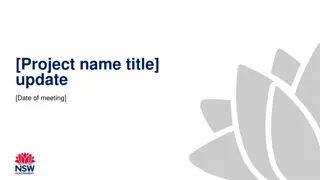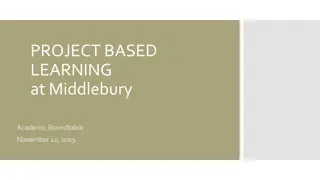Understanding Project-Based Learning for Effective Teaching and Learning
Project-Based Learning (PBL) is a teaching method where students engage in extended tasks to create real-world outputs. This presentation covers the definition, history, and principles of PBL, highlighting its benefits in teaching the Lower Secondary Curriculum. Participants will explore the features, roles of teachers and learners, and preliminary tasks in PBL, emphasizing the collaborative and experiential nature of this innovative approach.
- Project-Based Learning
- Teaching Method
- Student Engagement
- Curriculum Development
- Educational Innovation
Download Presentation

Please find below an Image/Link to download the presentation.
The content on the website is provided AS IS for your information and personal use only. It may not be sold, licensed, or shared on other websites without obtaining consent from the author. Download presentation by click this link. If you encounter any issues during the download, it is possible that the publisher has removed the file from their server.
E N D
Presentation Transcript
Project-based Learning A Presentation at the Techers workshop May 2023 Livingstone Kibuuka Master trainer New lower secondary curriculum
Session outcomes Participnts should be able to: Understand the use of projects as a method of teaching and learning. Appreciate the use of projects as a method of teaching their respective subjects. Guide learners through learning projects.
What is Project Based Learning? A method of teaching and learning whereby learners design, plan, and carry out an extended task that produces a publicly exhibited output: a functional product, publication, presentation or service(a lesson to others). It is related to inquiry-based learning, and problem-based learning. It is the outcome of the pragmatic education philosophy of John Dewey, an American philosopher and educationist. It was Propound by Prof. W.H. Kilpatrick of the University of Columbia and was perfected as a teaching method by Dr. J. A. Stevenson.
Contd It came up as a revolt against the traditional learning environment of the school which is usually characterized by passivity and lacks keenness and real life. Much of the subject content taught and many behaviors found in school do not conform to the desirable social life in the world outside school. It is an expression of the wide spread dissatisfaction with the bookish, encyclopedic and passive methods of teaching and learning. PBL may be carried out in the school or outside the school.
Watching a video clip on PBL Activity Using ideas from the video clip you have watched, discuss and respond to the following questions: 1. What are the features of PBL? 2. Why do you consider PBL relevant to delivering the LSC? 3. What role is played by the: teacher learner in PBL? 4. What are the preliminary tasks involved in carrying out a learning project?
Contd The essence of this method is to carry out a useful task in a group in which all the learners work co- operatively. This inspires a level of ambition and commitment much greater than is fueled by the incentive of getting good marks . Learning by doing and learning by living are the two basic principles involved and children learn through association, co-operation and activity.
Principles of the Project Method 1. The principle of freedom 2. The principle of reality 3. The principle of activity 4. The principle of experience 5. The principle of utility 6. The principle of interest 7. The principle of sociability
Major steps of the Project Method Providing a situation Choosing the Project Planning Carrying out the project (executing) Recording Evaluating
Steps Expounded Providing a situation A Project is never to be forced upon pupils. The teacher should provide situations by conservations on different topics, discussions on pictures, by telling stories or taking out learners on excursions and educational tours. Choosing/identifying a Project After a situation has been provided, the next step is the choice of a good project. The learner must feel that the project is their own.
Contd Planning After a suitable choice has been made, the next step is prepare a plan for the execution of the project. The entire planning is to be done by the learners under the guidance of the teacher. Each learner should be encouraged to participate in the discussion and offer his/her suggestions.
Contd Executing a Project When the plan is ready the teacher should encourage the learners to put it into practice. The teacher should challenge the learners to assign duties and distribute work among themselves, according to their individual interests and capacities. Then, they should be asked to work in co-operation with one another till the project is complete.
Contd Recording All the learners should maintain a project-book(portfolio) - a complete record of all the activities, connected with the project. It should include the choice of project, planning, discussions held, duties assigned, references and books consulted, information gathered, experiences gained, challenges faced, guidance sought etc. Evaluating a Project After the completion of project, the student should be asked to review their work. They should note their mistakes, if any, and see whether they had proceeded, according to the plan or not.





















![Project Initiation Document for [Insert.Project.name] [Insert.Project.number]](/thumb/226757/project-initiation-document-for-insert-project-name-insert-project-number.jpg)

